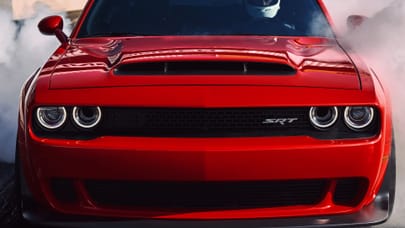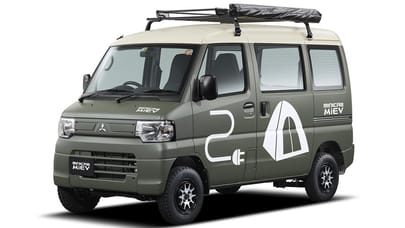

We're in a strip joint in Tijuana. This wasn't part of the plan. One moment, I was flaked out in the back of a van fresh off a long-haul flight; the next, I have a Corona in my hand, an equally shell-shocked photographer at my side, and close-quarters writhing is happening, lit red and bouncing to a deep beat. A man with a cruel face squares up to me. "What ju here for? You want woman? We've got l-o-t-s of womaaan." He drags the syllables out.
"Um. No thank you, not at the moment." "Ju here for the Ba-ha, right? I got gurrrls from aaall over Meh-hee-co. Everyone here for the Ba-ha. Gurrrls here for Ba-ha." The Baja 1000 is legendary. Not because - ahem - related service industries expand to meet demand while the race is on, but because this is the world's longest and most gruelling non-stop off-road race, a southbound blast down the finger of land that marks much of Mexico's Pacific coast. It's the biggest sporting event in the country, with an estimated 1.5 million spectators lining this year's 1,121.55-mile route. And it's not even held on a weekend. Perhaps a national holiday has been declared.
Pics: Justin LeightonThis feature first appeared in Top Gear magazine
Advertisement - Page continues below
Justin the photographer and I are here to take part. For me, this is something I've wanted to do forever, real bucket-list stuff. Justin's only bucket-related thought is that we're going to kick it. It probably doesn't help that you're free to be fantastically underprepared; you need no special licence to do this, just a green wristband gained at signing on and a suitably gnarly car. Ours is a Baja Challenge buggy, and it looks smaller, lighter and faster than it actually is.
It's powered by a naturally aspirated, rear-mounted Subaru flat-four which sends 175bhp through a four-speed manual to the rear wheels. That's where the fun starts: 18in of suspension travel and a set of tyres more craggy than my driving coach's face.

Rich Minga is a Hollywood stuntman by day, but his dusty eyes, grizzled features and laidback demeanour are pure Baja. We're in the scrubby hills above the race-start town of Ensenada to get a feel for the car. For me, this is about driving, but Justin, with an expression not unlike the one he wore the previous evening, has just found out that, as co-driver, he's responsible for all navigation and communication. This includes 16 radio channels. Oh God.
"And you, my friend," Rich says, turning to me, "Well, this terrain ain't gonna teach you sh*t about the Baja." Oh. I look out across the heavily eroded landscape, thankful at least that the race itself won't be as technically demanding as this mangled obstacle course of rock and earth. "Nope," Rich continues, kicking at the dirt. "The Baja is a kick in the crotch compared with this soft-a*se stuff."
Advertisement - Page continues below
I do at least learn how to drive the ‘car'. I learn that momentum is the single most important thing, that the gearbox is crummy, that there's no windscreen because it would be smashed by rocks, that the absence of doors aids egress when it rolls over, that I need to beware of the whoop-de-dos and that dust is an almighty issue. And I learn that I'll actually be glad that the steering has no feedback, no weight, yet is bewilderingly sharp. I have my doubts.
Aside from that, the buggy is a joyous device, something to be chucked at the landscape with wild abandon. Rich has witnessed my enthusiasm and decides a peg needs to be removed from my confidence. "You do realise how dangerous this event is?" I nod. "That drunk spectators dick around with the course and build booby traps?" Slower nod. "That faster cars will first tap, then ram you if you don't get out the way quick enough?" Small head movement. "That people die out there every year?"

Race day: it's five hours to race start. Wanting Justin to have confidence in his driver, I tell him I've slept brilliantly. This is a lie. I keep quiet and start the complex procedure of getting dressed. There are many layers and lots of leads that have to be plugged in. Only one of these attaches to my penis. Others control airflow to the helmet, radio communications and drinking water. There's a kidney protector, a neck collar, a dust skirt and an anti-chafe vest. When we march down to the car, we do so in slo-mo, feeling like Apollo astronauts. BC-6 looks immaculate. We stow our gear and wave our team-mates off. You don't do the Baja solo - well, you can, but only if you're certifiable.
The plan is that we'll do the first 400 miles before handing on to another pair, Jessi and Josh, who in turn will link up with a final pair, Steve and Doc (actually a dentist), for the last stint into La Paz. Provided I give BC-6 to them in one piece. This is preying on my mind. We're the last of six cars in the Baja Challenge class. One and two are Baja veterans, aiming for good results. Cars three through five are being driven by a posse of Monster-sponsored extreme sports athletes. Much fist-bumping occurs from people whose crotches have less ground clearance than the cars they're driving. I look across at Justin and feel pity. I've done some rallying, but he's a motorsport virgin, and I've a nasty feeling I'm about to deflower him in the most brutal way possible.

The flag drops, I fail to fluff the start and we're away. Two corners on tarmac, then a hard right to Armageddon. We plunge down into a culvert. Third gear, keep it pinned, keep the nose high through the dirt and ruts. This is insane. People are everywhere, a funnel that parts as you charge towards them. It's Group B all over again. Big purpose-built jump. I'd promised myself I wouldn't lift for this, but the thing's eight foot high. Oh well, in for a penny...
Justin's whoop through the intercom is one of relief as we touch down smoothly and power on. Big puddle, colour of caramel. We have no mudguards, no windscreen. A wall of mucky water cascades in. Justin's camera sits unprotected on his lap. At mile 0.5 of 395, the Nikon's trashed. Some swearing. Rather belatedly, he shoves it into a waterproof bag. It doesn't dry out for 55 miles.
We're climbing up into the hills now, through rough quarries, rough slums, stray dogs, chanting crowds. Some try to point us the wrong way, others gesture correctly, but you never know who's who, and Justin's semaphore waving is proving decidedly erratic. BANG. Love-tap number one. Didn't even see him coming, what with the dust and all. I leap for the verge with flea-like speed, and let the bouncy Beetle by. By way of thanks, it sprinkles us with coarse grey gravel. This combines with the rain that started falling a few minutes earlier. I wipe my visor, wondering how long it will be before doing so will only make matters worse.
About 20 minutes is the answer. We rattle and bang down a steep gully into a silt bed. It's not a big one, maybe 200 metres across, but in between I can see three stuck trucks, two fountaining silt dust into the air, the other motionless bar some frantic shovelling. Momentum is everything. Low gear. Nail it. It's like driving into a rich brown snowdrift, as fine dust explodes up and hangs there, motionless. We seem to be paddling, not touching the bottom and lost in a dry brown pea-souper. I have an idea where we came in, and by some miracle we pop out in the right place, only at 90 degrees to my intended direction of travel. I don't lift, just turn sharp right, nerf a bank, scatter spectators and make my escape.
Advertisement - Page continues below
I glance at my co-driver. He looks like a freshly dug potato. All I can see is dry brown earth. It's coated everything. We can't read any of the switches; the screens are covered. We flap at them with gloved hands, but, already moist from the rain, everything now turns muddy. It continues in this vein until late afternoon, when we finally drop down out of the hills, clatter through a rock garden that would have been absurdly daunting three hours before and onto a road section. The relief is palpable. We've done 88 miles, in which we've banged tyres with a Class One buggy, cannoned through a blind yumps section, discovered our horn is actually a siren (fulfilling several childhood fantasies), very satisfyingly outbraked a 400bhp truck into a fast corner and a million other things besides.
I haven't been able to hear a word Justin said, I can still taste silt dust and it's been the toughest, most ferocious 88 miles of my driving life. We're both tired, and, despite the best efforts of this suspension, the physical toll is starting to tell. We still have 300 miles to run.

But we're into the desert now, under clearer skies, more open vistas. We have a great section, pounding over firm sand, scooting around stunted vegetation, helicopter filming us from cactus level, going fast, going well, catching others. "You know what this means?" Justin says over an intercom that's miraculously repaired itself, "We're going to come a cropper soon."
Prophetic words. We're flat in fourth, insect-like suspension nibbling at the surface, skating quickly along. We don't see the washout until far too late. We fly off the lip of the dried-up riverbed so fast that the point of impact is the bank on the other side. Solid chassis against solid rock. Hands and feet and heads fly around the cockpit as the buggy ricochets into the sky, launching itself over the lip. I'm shaking so hard I can't put my feet on the pedals, can't grip the wheel, can't find a gear. I've never been scared when racing, but I'm scared now. And in pain. I groggily ask Justin if he's OK, but the noise I make is wheezing bagpipes.
Advertisement - Page continues below
We back off for a while, but then we pass BC-1 fixing a puncture, and soon after catch BC-4. To put it mildly I find this... motivating, and quietly promise myself that we'll beat them to the pit stop. The pit stop coincides with nightfall. We check the notes. The next section is rough. "How rough can it be after what we've already been through?" Justin queries.
The Whoops. Sound fun, right? I imagine they look fun from outside - lateral sandy ridges like static waves in the desert. The Trophy Trucks skim over them, skipping from crest to crest, borne aloft on three feet of suspension travel. "How long do these go on for?" I ask Justin, my voice yodelling with the yumps. "Not sure, but it can't be much further." We're a few hundred yards in, and already the bucking motion as we nose up and down is giving us motion sickness. I try speeding up, but that launches us off one and crashing into the next. The car can probably take it, but we can't. 35mph it is, then. We continue. I work out coping strategies: letting my body relax, my jaw hang loose, my lungs auto-operating via the car's compression and release.

We do 10 miles of squeeze, suck, bang, blow. My insides feel distinctly odd. But we've barely begun. The Whoops last for 80 miles. At the end, it feels like a vicious imp is pulling some pipes off my heart. My forearms barely function, my legs are numb and, for the last hour, I've heard little from Justin apart from some distressing cries of pain. This, apparently, is motor racing. But the car is the only thing that's actually broken at the 250-mile pit stop. We'd started to hear a flapping noise, which turns out to be the rear CV joint gaiters. The rear driveshafts need to be replaced. This will take an hour. We're last in our class, but all I feel is relief.
The rest does us good. Well, I fall asleep on a road section, but apart from that and the time Justin calls a right early and I end up doing laps of someone's campfire, we're all good. In the groove. Battered, grimy and knackered like proper veterans, we curse the support trucks that cheekily use the race course as a short cut, blasting through their dust without lifting, tooting our siren, flashing our massive light packs. All is well until we strike, well, I'm not sure what, but the impact is considerable. There's a scream and then silence. That's it. I've broken Justin. I'm going to have to stop in this dark, hostile desert and call for help.

I slow down to crawling pace. I've really hurt a guy I care about, and that makes me feel awful. For a few miles, we trundle, as Justin tests his neck. It's manageable, and for that I'm weepily thankful.
The last 50 miles are unforgettable. We struggle through the swamp, floorpan deep in mud and water, then suddenly we're in the cactus forest. It's so stunning, we temporarily forget the pain. Picked out by our ferocious headlights, the cacti rise from the desert like spiny sentinels, appearing ghost-like behind the sheen of white dust that hangs in the air. It's hauntingly beautiful, so calm and quiet compared with the jack-hammering buggy. And then, suddenly, we're on a road, and only five miles from handover. And we're elated.

The lights of our pits are the most welcoming we've ever seen. Justin and I unbuckle harnesses and collapse into a brotherly hug. Twelve hours done. I pat the buggy. We're still last, an hour down, as Josh and Jessi head into the dark. It's the last we see of the buggy for 31 hours. They have a nightmare. Josh rolls, gets it stuck in silt, hits a motorbike, breaking the rider's foot, and having given himself the mental and physical jitters, hands driving duties back to Jessi. A wrong direction call sees them drive off a small cliff, breaking the front suspension, leading to a five-hour delay.

It limps home in 43 hours and 54 minutes, less than six minutes inside the 44-hour limit. But it's made it (one of fewer than 180 to do so, from a 300-strong starting list), even though Doc and Steve had to stop every 35 miles to buy power steering fluid from spectators. BC-6 dribbles on the podium. We smile, and toast with warm beer.

The Baja 1000 is a race that strips you, teaches you about pain thresholds, concentration levels, how you perform in adversity. It's the only racing I've ever done where the limiting factor isn't the car or the surface, but you. That's a tough lesson to learn. But we've done it, we made it. We fought the Baja, and we won.
Trending this week
- Car Review
Alpine A390
- Car Review
Honda Prelude







